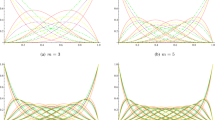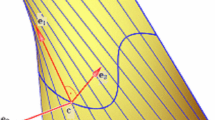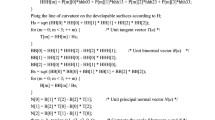Abstract
In this paper, we propose a novel method for constructing developable surfaces using generalized C-Bézier bases with shape parameters. Based on the duality between points and planes in 3D projective space, the generalized developable C-Bézier surfaces, whose shape can be adjusted by changing multiple shape parameters, are designed using control planes with extensional C-Bézier basis functions. With the shape parameters taking different values, a family of developable surfaces can be constructed, which keeps most of characteristics of classic developable Bézier surfaces. Furthermore, some interesting properties of the new developable surfaces, as well as the geometric continuity conditions between two adjacent generalized developable C-Bézier surfaces, are investigated. Finally, we illustrate the convenience and efficiency of the proposed methods by several convictive and representative numerical examples.













Similar content being viewed by others
References
Aumann G (2003) A simple algorithm for designing developable Bézier surfaces. Comput Aided Geom Des 20(8):601–619
Aumann G (2004) Degree elevation and developable Bézier surfaces. Comput Aided Geom Des 21(7):661–670
Bodduluri R, Ravani B (1993) Design of developable surfaces using duality between plane and point geometries. Comput Aided Des 25(10):621–632
Bodduluri R, Ravani B (1994) Geometric design and fabrication of developable Bézier and B-spline surfaces. J Mech Des 116(4):1042–1048
Chen M, Tang K (2013) G2 quasi-developable Bézier surface interpolation of two space curves. Comput Aided Des 45(11):1365–1377
Chen DR, Wang GJ (2003a) Developable Bézier parametric surfaces. J Comput Aided Des Comput Graph 15(5):570–575
Chen Q, Wang G (2003b) A class of Bézier-like curves. Comput Aided Geom Des 20(1):29–39
Chu CH, Sequin CH (2002) Developable Bézier patches properties and design. Comput Aided Des 34(5):511–527
Elber G (1995) Model fabrication using surface layout projection. Comput Aided Des 27(4):283–291
Farin G (2002) Curves and surfaces for CAGD: a practical guide, 5th edn. Academic Press, San Diego
Fernandez-Jambrina L (2007) B-spline control nets for developable surfaces. Comput Aided Geom Des 24(4):189–199
Frey W, Bindschadler D (1993) Computer aided design of a class of developable Bézier surfaces, vol 8057. General Motors R & D Publication, New York
Gunter W, Peter F (1988) Computer-aided treatment of developable surfaces. Comput Graph 12(1):39–51
Hu G, Cao HX, Qin XQ et al (2017) Geometric design and continuity conditions of developable λ-Bézier surfaces. Adv Eng Soft 114:235–245
Hu G, Bo CC, Wei G, Qin XQ (2020) Shape-adjustable generalized Bézier surfaces: construction and its geometric continuity conditions. Appl Math Comput 378:125215
Hwang HD, Yoon SH (2015) Constructing developable surfaces by wrapping cones and cylinders. Comput Aided Des 58:230–235
Li CY, Wang RH, Zhu CG (2011) Design and G1 connection of developable surfaces through Bézier geodesics. Appl Math Comput 218(7):3199–3208
Li CY, Wang RH, Zhu CG (2013) An approach for designing a developable surface through a given line of curvature. Comput Aided Des 45(3):621–627
Lin SH, Wang GZ (2005) Extension of definition interval for C-curves. J Comput Aided Des Comput Graph 17(10):2281–2285
Liu Y, Pottman H, Wallner J et al (2006) Geometric modeling with conical meshes and developable surfaces. In: ACM SIGGRAPH, pp 681–689
Mandal C, Qin H, Vemuri BC (2000) Dynamic modeling of butterfly subdivision surfaces. IEEE Trans Visual Comput Graph 6(3):265–287
Pottmann H, Farin G (1995) Developable rational Bézier and B-spline surfaces. Comput Aided Geom Des 12(5):513–531
Pottmann H, Wallner J (1998) Approximation algorithms for developable surfaces. Comput Aided Geom Des 16(6):539–556
Schneider M (1997) Interpolation with developable strip-surfaces consisting of cylinders and cones. In: Proceedings of the international conference on mathematical methods for curves and surfaces II Lillehammer, 1997. Vanderbilt University, 1998, pp 437–444
Tang C, Bo P, Wallner J, Pottman H (2016) Interactive design of developable surfaces. ACM Trans Graph 35(2):1–12
Yang JQ, Zhou M, Ye ZL et al (2007) Geometric design of adjustably developable surfaces. China Mech Eng 18(12):1425–1429
Zhang XW, Wang GJ (2006) A new algorithm for designing developable Bézier surfaces. J Zhejiang Univ Sci A 7(12):2050–2056
Zhao HY, Wang GJ (2008) A new method for designing a developable surface utilizing the surface pencil through a given curve. Prog Nat Sci 18(1):105–110
Zhou M, Peng GH, Ye ZL (2004) Design of developable surfaces by using duality between plane and point geometries. J Comput Aided Des Comput Graph 16(10):1401–1406
Zhou M, Yang JQ, Zheng HC, Song WJ (2013) Design and shape adjustment of developable surfaces. Appl Math Model 37:3789–3801
Acknowledgements
We thank to the anonymous reviewers for their insightful suggestions and recommendations, which led to the improvements of presentation and content of the paper. This work is supported by the National Natural Science Foundation of China (Nos. 51875454 and 11702214).
Author information
Authors and Affiliations
Corresponding author
Ethics declarations
Conflict of interest
The authors declare that there is no conflict of interests regarding the publication of this paper.
Additional information
Communicated by Frederic Valentin.
Publisher's Note
Springer Nature remains neutral with regard to jurisdictional claims in published maps and institutional affiliations.
Appendix
Appendix
1.1 A. The proof of the terminal properties for generalized C-Bézier basis functions
Proof
By induction on n. When n = 2, from (4) and (5), we obtain
Now assume the terminal properties in (9) hold for n = r. When n = r + 1, from formula (6) and the inductive hypothesis, for any \(i = {0},{1}, \ldots ,r + 1\), we have
-
a.
for t = 0, \(w_{0,r + 1} (0{\kern 1pt} ;\,\alpha_{1} ) = 1 - \int_{0}^{{0}} {\delta_{0,r - 1} w_{0,r - 1} {(}x;\alpha_{1} {\text{)d}}x} = 1,\)
$$ w_{i,r + 1}^{(0)} (0;\,\alpha_{i} ,\alpha_{{i + {1}}} ) = w_{i,r + 1} (0;\,\alpha_{i} ,\alpha_{{i + {1}}} ) = 0,\;i = 1,2, \ldots ,r,\;w_{i,r + 1}^{(0)} (0;\,\alpha_{i} ,\alpha_{{i + {1}}} ) = w_{i,r + 1} (0;\,\alpha_{i} ,\alpha_{{i + {1}}} ) = 0,\;i = 1,2, \ldots ,r, $$$$ w_{i,r + 1}^{(0)} (0;\,\alpha_{i} ,\alpha_{{i + {1}}} ) = w_{i,r + 1} (0;\,\alpha_{i} ,\alpha_{{i + {1}}} ) = 0,\;i = 1,2, \ldots ,r,\;w_{r + 1,r + 1}^{(0)} (0;\,\alpha_{r + 1} ) = w_{r + 1,r + 1} (0;\,\alpha_{r + 1} ) = 0, $$$$ \begin{aligned} w_{i,r + 1}^{(j)} (0;\,\alpha_{i} ,\alpha_{i + 1} ) & = \left. {\frac{{{\text{d}}^{j} }}{{{\text{d}}t^{j} }}\left[ {\int_{0}^{t} {\left[ {\delta_{i - 1,r} \tilde{w}_{i - 1,r} (x;\alpha_{i} ) - \delta_{i,r} \tilde{w}_{i,r} (x;\alpha_{i + 1} )} \right]{\text{d}}x} } \right]} \right|_{t = 0} \\ & = \left. {\left[ {\delta_{i - 1,r} \tilde{w}_{i - 1,r}^{(j - 1)} (t;\alpha_{i} ) - \delta_{i,r} \tilde{w}_{i,r}^{(j - 1)} (t;\alpha_{i + 1} )} \right]} \right|_{t = 0} \\ & = \delta_{i - 1,r} w_{i - 1,r}^{(j - 1)} (0;\alpha_{i} ,\alpha_{i} ) - \delta_{i,r} w_{i,r}^{(j - 1)} (0;\alpha_{i + 1} ,\alpha_{i + 1} ) \\ & = 0,\;\,j = {1},{2}, \ldots ,i - 1,\,\;i = 2,3, \ldots ,r - 1, \\ \end{aligned} $$$$ \begin{aligned} w_{r,r + 1}^{(j)} (0;\,\alpha_{r} ,\alpha_{{r + {1}}} ) & = \left. {\frac{{{\text{d}}^{j} }}{{{\text{d}}t^{j} }}\left[ {\int_{0}^{t} {\left[ {\delta_{r - 1,r} \tilde{w}_{r - 1,r} (x;\alpha_{r} ) - \delta_{r,r} w_{r,r} (x;\alpha_{r + 1} )} \right]{\text{d}}x} } \right]} \right|_{t = 0} \\ & = \left. {\left[ {\delta_{r - 1,r} \tilde{w}_{r - 1,r}^{(j - 1)} (t;\alpha_{r} ) - \delta_{r,r} w_{r,r}^{(j - 1)} (t;\alpha_{r + 1} )} \right]} \right|_{t = 0} \\ & = \delta_{r - 1,r} w_{r - 1,r}^{(j - 1)} (0;\alpha_{r} ,\alpha_{r} ) - \delta_{r,r} w_{r,r}^{(j - 1)} (0;\alpha_{r + 1} ) \\ & = 0,\,\;j = {1},{2}, \ldots ,r - 1, \\ \end{aligned} $$$$ w_{r + 1,r + 1}^{(j)} (0;\,\alpha_{r + 1} ) = \left. {\frac{{{\text{d}}^{j} }}{{{\text{d}}t^{j} }}\left[ {\int_{0}^{t} {\delta_{r,r} w_{r,r} {(}x;\alpha_{r + 1} {\text{)d}}x} } \right]} \right|_{t = 0} = \delta_{r,r} w_{r,r}^{(j - 1)} {(}0;\alpha_{r + 1} {)} = 0,\,\;j = {1},{2}, \ldots ,r; $$$$ \begin{aligned} w_{{{0},r + {1}}}^{{(1)}} (0;\,\alpha_{{1}} ) & = \left. {\frac{{\text{d}}}{{{\text{d}}t}}\left[ {1 - \int_{0}^{t} {\delta_{0,r} w_{0,r} {(}x;\alpha_{1} {\text{)d}}x} } \right]} \right|_{t = 0} = \left. {\left[ { - \delta_{0,r} w_{0,r} {(}t;\alpha_{1} {)}} \right]} \right|_{t = 0} = - \delta_{0,(r + 1) - 1} w_{0,r} {(0}{\kern 1pt} ;\alpha_{1} {)} \\ & = - \delta_{0,(r + 1) - 1} \times {1} = - \delta_{{0,(r + {1}) - 1}} ; \\ \end{aligned} $$ -
b.
for t = 1,
$$ w_{r + 1,r + 1} (1;\,\alpha_{r + 1} ) = \delta_{r,r} \int_{0}^{1} {w_{r,r} {(}x;\alpha_{r + 1} {\text{)d}}x} = \left[ {\int_{0}^{1} {w_{r,r} {(}x;\alpha_{r + 1} {\text{)d}}x} } \right]^{ - 1} \int_{0}^{1} {w_{r,r} {(}x;\alpha_{r + 1} {\text{)d}}x} = 1\;, $$$$ \begin{gathered} w_{0,r + 1}^{{({0})}} (1;\,\alpha_{1} ) = w_{0,r + 1} (1;\,\alpha_{1} ) = 1 - \int_{0}^{{1}} {\delta_{0,r} w_{0,r} {(}x;\alpha_{1} {\text{)d}}x} \\ = {1} - \frac{{\int_{0}^{{1}} {w_{0,r} {(}x;\alpha_{1} {\text{)d}}x} }}{{\delta_{0,r} }} = {1} - \frac{{\int_{0}^{{1}} {w_{0,r} {(}x;\alpha_{1} {\text{)d}}x} }}{{\int_{0}^{{1}} {w_{0,r} {(}t;\alpha_{1} {\text{)d}}t} }} = 1 - 1 = 0, \\ \end{gathered} $$$$ w_{i,r + 1}^{(0)} (1;\,\alpha_{i} ,\alpha_{{i + {1}}} ) = w_{i,r + 1} (1;\,\alpha_{i} ,\alpha_{{i + {1}}} ) = 0,\,\;i = 1,2, \ldots ,r, $$$$ w_{0,r + 1}^{(k)} (1;\,\alpha_{1} ) = \left. {\frac{{{\text{d}}^{k} }}{{{\text{d}}{\kern 1pt} t^{k} }}\left[ {1 - \int_{0}^{t} {\delta_{0,r} w_{0,r} {(}x;\alpha_{1} {\text{)d}}x} } \right]} \right|_{t = 1} = - \delta_{0,r} w_{0,r}^{(k - 1)} {(}0;\alpha_{1} {)} = 0,\,\;k = {1},{2}, \ldots ,r, $$$$ \begin{gathered} w_{1,r + 1}^{(k)} (1;\,\alpha_{1} ,\alpha_{2} ) = \left. {\frac{{{\text{d}}^{k} }}{{{\text{d}}{\kern 1pt} t^{k} }}\left[ {\int_{0}^{t} {\left[ {\delta_{0,r} w_{0,r} (x;\alpha_{1} ) - \delta_{1,r} \tilde{w}_{1,r} (x;\alpha_{2} )} \right]{\text{d}}x} } \right]} \right|_{t = 1} \\ = \left. {\left[ {\delta_{0,r} w_{0,r}^{(k - 1)} (t;\alpha_{1} ) - \delta_{1,r} \tilde{w}_{1,r}^{(k - 1)} (t;\alpha_{2} )} \right]} \right|_{t = 1} \\ = \delta_{0,r} w_{0,r}^{(k - 1)} (1;\alpha_{1} ) - \delta_{1,r} w_{1,r}^{(k - 1)} (1;\alpha_{2} ,\alpha_{2} ) \\ = 0,\,\;k = 1,2, \ldots ,r - 1{,} \\ \end{gathered} $$$$ \begin{gathered} w_{i,r + 1}^{(k)} (1;\,\alpha_{i} ,\alpha_{i + 1} ) = \left. {\frac{{{\text{d}}^{k} }}{{{\text{d}}{\kern 1pt} t^{k} }}\left[ {\int_{0}^{t} {\left[ {\delta_{i - 1,r} \tilde{w}_{i - 1,r} (x;\alpha_{i} ) - \delta_{i,r} \tilde{w}_{i,r} (x;\alpha_{i + 1} )} \right]{\text{d}}x} } \right]} \right|_{t = 1} \\ = \left. {\left[ {\delta_{i - 1,r} \tilde{w}_{i - 1,r}^{(k - 1)} (t;\alpha_{i} ) - \delta_{i,r} \tilde{w}_{i,r}^{(k - 1)} (t;\alpha_{i + 1} )} \right]} \right|_{t = 1} \\ = \delta_{i - 1,r} w_{i - 1,r}^{(k - 1)} (1;\alpha_{i} ,\alpha_{i} ) - \delta_{i,r} w_{i,r}^{(k - 1)} (1;\alpha_{i + 1} ,\alpha_{i + 1} ) \\ = 0,\,\;k = {1},{2}, \ldots ,r - i,\,\;i = {2},{3}, \ldots ,r - 1; \\ \end{gathered} $$ -
c.
for t = 0 and \(i = j\),
$$ \begin{gathered} w_{{{1},r + 1}}^{{({1})}} (0;\,\alpha_{{1}} ,\alpha_{{2}} ) = \left. {\frac{{{\text{d}}^{1} }}{{{\text{d}}t^{1} }}\left[ {\int_{0}^{t} {\left[ {\delta_{0,r} w_{0,r} (x;\alpha_{1} ) - \delta_{1,r} \tilde{w}_{1,r} (x;\alpha_{2} )} \right]{\text{d}}x} } \right]} \right|_{t = 0} \\ = \delta_{0,r} w_{0,r} (0;\alpha_{1} ) - \delta_{1,r} w_{1,r} (0;\alpha_{2} ,\alpha_{2} ) = \delta_{0,r} \times 1 - \delta_{1,r} \times 0 = \delta_{0,r} , \\ \end{gathered} $$$$ \begin{gathered} w_{i,r + 1}^{(i)} (0;\,\alpha_{i} ,\alpha_{i + 1} ) = \left. {\frac{{{\text{d}}^{i} }}{{{\text{d}}t^{i} }}\left[ {\int_{0}^{t} {\left[ {\delta_{i - 1,r} \tilde{w}_{i - 1,r} (x;\alpha_{i} ) - \delta_{i,r} \tilde{w}_{i,r} (x;\alpha_{i + 1} )} \right]{\text{d}}x} } \right]} \right|_{t = 0} \\ = \left. {\left[ {\delta_{i - 1,r} \tilde{w}_{i - 1,r}^{(i - 1)} (t;\alpha_{i} ) - \delta_{i,r} \tilde{w}_{i,r}^{(i - 1)} (t;\alpha_{i + 1} )} \right]} \right|_{t = 0} \\ = \delta_{i - 1,r} w_{i - 1,r}^{(i - 1)} (0;\alpha_{i} ,\alpha_{i} ) - \delta_{i,r} w_{i,r}^{(i - 1)} (0;\alpha_{i + 1} ,\alpha_{i + 1} ) \\ = \delta_{i - 1,r} \times \left[ {\delta_{{(i - {1}) - 1,r - 1}} \delta_{(i - 1) - 2,r - 2} \ldots \delta_{0,r - (i - 1)} } \right] - \delta_{i,r} \times {0} \\ = \delta_{i - 1,(r + 1) - 1} \delta_{i - 2,(r + 1) - 2} \ldots \delta_{0,(r + 1) - i} ,\,\;i = {2},{3}, \ldots ,r - 1, \\ \end{gathered} $$$$ \begin{gathered} w_{r,r + 1}^{(r)} (0;\,\alpha_{r} ,\alpha_{r + 1} ) = \left. {\frac{{{\text{d}}^{r} }}{{{\text{d}}t^{r} }}\left[ {\int_{0}^{t} {\left[ {\delta_{r - 1,r} \tilde{w}_{r - 1,r} (x;\alpha_{r} ) - \delta_{r,r} w_{r,r} (x;\alpha_{r + 1} )} \right]{\text{d}}x} } \right]} \right|_{t = 0} \\ = \left. {\left[ {\delta_{r - 1,r} \tilde{w}_{r - 1,r}^{(r - 1)} (t;\alpha_{r} ) - \delta_{r,r} w_{r,r}^{(r - 1)} (t;\alpha_{r + 1} )} \right]} \right|_{t = 0} \\ = \delta_{r - 1,r} w_{r - 1,r}^{(r - 1)} (0;\alpha_{r} ,\alpha_{r} ) - \delta_{r,r} w_{r,r}^{(r - 1)} (0;\alpha_{r + 1} ) \\ = \delta_{r - 1,r} \times \left[ {\delta_{{(r - {1}) - 1,r - 1}} \delta_{(r - 1) - 2,r - 2} \ldots \delta_{0,r - (r - 1)} } \right] - \delta_{r,r} \times 0 \\ = \delta_{r - 1,(r + 1) - 1} \delta_{r - 2,(r + 1) - 2} \cdots \delta_{0,(r + 1) - r} ; \\ \end{gathered} $$ -
d.
for \(i = j = r + 1\),
$$ \begin{gathered} w_{r + 1,r + 1}^{(r + 1)} (0;\,\alpha_{r + 1} ) = \left. {\frac{{{\text{d}}^{r} }}{{{\text{d}}{\kern 1pt} t^{r} }}\left[ {\delta_{r,r} w_{r,r} (t;\,\alpha_{r + 1} )} \right]} \right|_{t = 0} = \delta_{r,r} w_{r,r}^{(r)} (0;\,\alpha_{r + 1} ) \\ = \delta_{r,r} \left[ {\delta_{r - 1,r - 1} \delta_{r - 2,r - 2} \cdots \delta_{{{1},{1}}} \delta (\alpha_{r + 1} )} \right] \\ = \delta_{r,r} \delta_{r - 1,r - 1} \cdots \delta_{{{1},{1}}} \delta (\alpha_{r + 1} ),\;\,\delta (\alpha_{r + 1} ) = \alpha_{r + 1} {/}\sin \alpha_{r + 1} . \\ \end{gathered} $$
These indicate that the terminal properties listed in (9) also hold for n = r + 1. This ends the proof.
1.2 The proof of linear independence for generalized C-Bézier basis functions
Proof
To check the linear independence of \(\{ w_{{{0},n}} (t)\;,\;w_{{{1},n}} (t), \ldots ,w_{n,n} (t)\}\), we consider a linear combination as follows:
By taking the k-order derivative of Eq. (56) about t on both sides, we get
For t = 0, according to (57) and combining with (9), we can obtain the following system of linear equations with respect to \(l_{i} ,\,\;i = 0,1, \ldots ,n\)
where \(w_{0,n}^{(0)} (0;\,\alpha_{1} ) = w_{0,n} (0;\,\alpha_{1} ) = {1}\), \(w_{i,n}^{(i)} (0;\,\alpha_{i} ,\alpha_{i + 1} ) \ne 0,\,\;i = 1,2, \ldots ,n - 1\) and \(w_{n,n}^{(n)} (0;\,\alpha_{n} ) \ne 0\).
Thus, it is obvious that \(l_{i} = 0,\;i = 0,1, \ldots ,n\), meaning that \(w_{i,n} (t),\,\;i = 0,1, \ldots ,n\) are linearly independent.
Rights and permissions
About this article
Cite this article
Hu, G., Cao, H., Wu, J. et al. Construction of developable surfaces using generalized C-Bézier bases with shape parameters. Comp. Appl. Math. 39, 157 (2020). https://doi.org/10.1007/s40314-020-01185-9
Received:
Revised:
Accepted:
Published:
DOI: https://doi.org/10.1007/s40314-020-01185-9
Keywords
- Developable C-Bézier surfaces
- Extensional C-Bézier basis functions
- Shape parameter
- Geometric continuity condition




